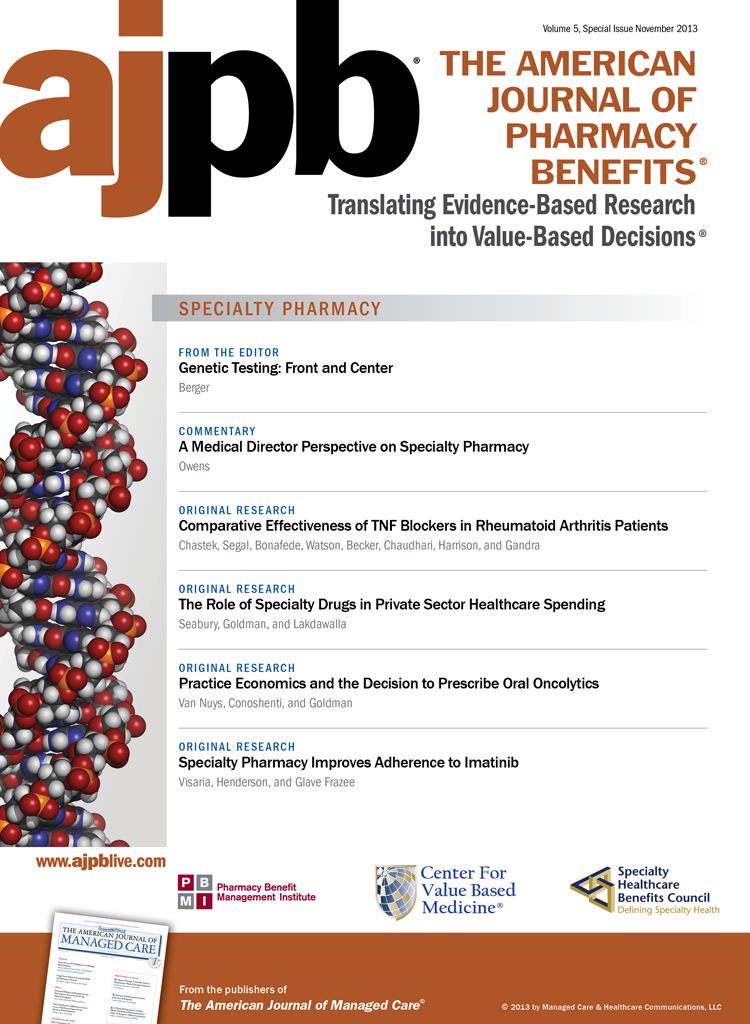Publication
Article
AJPB® Translating Evidence-Based Research Into Value-Based Decisions®
A Medical Director Perspective on Specialty Pharmacy
Author(s):
This article reviews current drug therapies for heart failure and therapy integration into a patient care framework improving patient adherence and quality of life and decreasing risk of readmission to acute care facilities.
It is almost impossible to go to a meeting or have a discussion about pharmaceuticals in 2013 without the topic of specialty pharmaceuticals arising. Health plans and benefit managers note that the recent growth in the number of specialty drug launches and use of these products for many previously untreatable diseases has resulted in major clinical advances—but at a cost.
On one hand, the patent cliff of recent years has led to generic dispensing rates of 80% or more and cost trend decreases for small-molecule agents. For instance, in 2012 alone, $28.9 billion worth of brand drugs became available in generic form. The result was an $11.4 billion drop in drug spending for brand drugs to $230.2 billion in the US market. This is clearly uncharted territory for many benefit plan managers.
At the same time, several data sources show that specialty drugs represent the fastest growing sector of pharmacy spending today. We only have to take a brief look back to see that only 10 years ago, most specialty drugs were injectable agents used to treat conditions like rheumatoid arthritis, multiple sclerosis, and growth disorders. Today, the agents that are considered specialty pharmaceuticals include many oral drugs and even some inhaled agents. In just over 2 decades the specialty drug marketplace has grown substantially. In 1990, 10 specialty drugs were on the market. By 2012 nearly 300 agents met the definition of a specialty pharmaceutical. Even more astounding is that approximately 40% of current agents in the pharmaceutical pipeline are likely to be considered specialty agents when they are released to the market.
The year 2012 provides a good example of the growth of specialty pharmaceuticals. The US Food and Drug Administration (FDA) approved 39 new agents last year, the most in 15 years. Of those newly approved drugs, 25 can be classifi ed as specialty agents. Of those 25 specialty drugs, more than one-half (13 agents) were for cancer.1 In 2013 the FDA has already approved 11 new agents that can be classifi ed as specialty drugs. The emphasis on specialty drug development is here to stay, and it will become the major driver of pharmacy cost in the future.
According to Express Scripts’ 2012 Drug Trend Report, specialty drugs had an annual yearly cost of just over $170 per member per year (PMPY) in 2012 and the growth trend that year was 17.1%; this trend is expected to grow to 22% by 2014.2 The report further notes that specialty drug growth shows no signs of slowing in the near future due to the combination of price inflation and new drug approvals. In fact, some industry experts have predicted that specialty drugs will represent 45% of pharmaceutical manufacturer sales by 2017.
A recent report by Artemetrx revealed some even more astounding projections: “By 2018, specialty drug spend is expected to surpass traditional drug spend (ie, non-specialty) for most plan sponsors due to the double-digit growth in specialty that will continue for the foreseeable future across both the pharmacy and medical benefits.”3 These projections were based on a careful
analysis of both the medical and pharmacy specialty utilization. In the past, many studies reported that specialty drug spending represented only 15% to 20% of total drug spending. However, with the inclusion of specialty drugs covered under the medical benefit, including those used in hospital inpatient stays, the Artemetrx analysts concluded that specialty drug spending already represented 30% of total drug spending for the typical commercial plan sponsor in 2012.3
One of the more startling conclusions reached in this analysis is that specialty spending will go from $290 PMPY in 2012 up to $845 PMPY by 2018 because of the strong pipeline, price infl ation, and expanded indications.3 Restated, this means that even a moderately sized plan of 1 million members will be approaching $1 billion in specialty drug spending annually, almost half of which will be oncology related. With annual trends of 20% growth, that number will again double in less than 4 years!
Those staggering numbers lead one to speculate about how plans and the customers they represent will manage this category in the future. Certainly, plan benefit managers must have information about what drug works best clinically and for whom it will be most effective. In this issue of The American Journal of Pharmacy Benefits dedicated to specialty pharmacy, we find much useful information that may help guide decisions on how to effectively manage the specialty benefit. For instance, the article titled “Comparative Effectiveness of TNF Blockers in Rheumatoid Arthritis Patients” provides useful comparative information about 2 of the most commonly used self-injectable agents for the treatment of rheumatoid arthritis. We also gain insight about how specialty pharmacies can engage patients and improve medication adherence for the treatment of chronic myelogenous leukemia.
It is clear that there is no one single answer about how to best manage the specialty pharmacy benefit. Moreover, the impact of these agents on the overall medical cost curve is still somewhat unknown. For instance, will some chronic diseases ultimately cost the system less due to the potential for specialty drugs to modify the course of a chronic disease? Or will these potential cost savings be outweighed by a growing number of patients living longer with chronic conditions? What will be the impact of biosimilar agents? The answers to these questions lie in the future. Meanwhile, effective management of this benefit and the costs associated with it will be a challenge for plan benefi t managers. The American Journal of Pharmacy Benefits will continue to provide its readership with important information on this sector.







